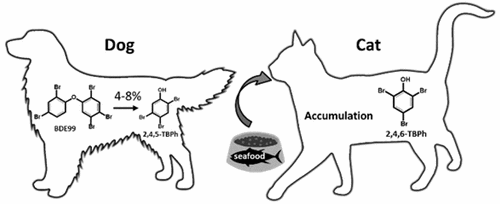当前位置:
X-MOL 学术
›
Environ. Sci. Technol.
›
论文详情
Our official English website, www.x-mol.net, welcomes your feedback! (Note: you will need to create a separate account there.)
Anthropogenic and Naturally Produced Brominated Phenols in Pet Blood and Pet Food in Japan
Environmental Science & Technology ( IF 11.4 ) Pub Date : 2017-09-13 00:00:00 , DOI: 10.1021/acs.est.7b01009 Hazuki Mizukawa 1 , Kei Nomiyama 1 , Susumu Nakatsu 2 , Miyuki Yamamoto 1 , Mayumi Ishizuka 3 , Yoshinori Ikenaka 3, 4 , Shouta M.M. Nakayama 3 , Shinsuke Tanabe 1
Environmental Science & Technology ( IF 11.4 ) Pub Date : 2017-09-13 00:00:00 , DOI: 10.1021/acs.est.7b01009 Hazuki Mizukawa 1 , Kei Nomiyama 1 , Susumu Nakatsu 2 , Miyuki Yamamoto 1 , Mayumi Ishizuka 3 , Yoshinori Ikenaka 3, 4 , Shouta M.M. Nakayama 3 , Shinsuke Tanabe 1
Affiliation

|
Present study determined concentrations and residue patterns of bromophenols (BPhs) in whole blood samples of pet cats and pet dogs collected from veterinary hospitals in Japan. BPhs concentrations were higher in cat blood than in dog blood, with statistically insignificant differences (p = 0.07). Among the congeners, 2,4,6-tribromophenol (TBPh) constituted the majority of BPhs (>90%) detected in both species. Analysis of commercial pet food to estimate exposure routes showed that the most abundant congener in all pet food samples was 2,4,6-TBPh, accounting for >99% of total BPhs. This profile is quite similar to the blood samples of the pets, suggesting that diet might be an important exposure route for BPhs in pets. After incubation in polybrominated diphenyl ether (PBDE) mixtures (BDE-47, BDE-99 and BDE-209), 2,4,5-TBPh was found in dog liver microsomes but not in cat liver microsomes, implying species-specific metabolic capacities for PBDEs. Formation of 2,4,5-TBPh occurred by hydroxylation at the 1′ carbon atom of the ether bond of BDE-99 is similar to human study reported previously. Hydroxylated PBDEs were not detected in cats or dogs; therefore, diphenyl ether bond cleavage of PBDEs can also be an important metabolic pathway for BPhs formation in cats and dogs.
中文翻译:

日本宠物血液和宠物食品中的人为和自然产生的溴代苯酚
目前的研究确定了从日本兽医医院收集的宠物猫和宠物狗全血样品中溴酚(BPhs)的浓度和残留模式。猫血中BPhs浓度高于狗血中BPhs浓度,差异无统计学意义(p= 0.07)。在同类物中,2,4,6-三溴苯酚(TBPh)构成了在两个物种中检测到的大多数BPhs(> 90%)。对商业宠物食品进行分析以估计接触途径后发现,所有宠物食品样品中最丰富的同类物为2,4,6-TBPh,占BPh总数的99%以上。该特征与宠物的血液样本非常相似,表明饮食可能是宠物中BPhs的重要暴露途径。在多溴二苯醚(PBDE)混合物(BDE-47,BDE-99和BDE-209)中温育后,在犬肝微粒体中发现了2,4,5-TBPh,但在猫肝微粒体中未发现,这意味着物种特异性的代谢能力用于多溴二苯醚。BDE-99醚键的1'碳原子上的羟基化作用导致2,4,5-TBPh的形成与先前报道的人类研究相似。在猫或狗中未检测到羟基化的多溴二苯醚。因此,PBDEs的二苯醚键裂解也可能是猫和狗中BPhs形成的重要代谢途径。
更新日期:2017-09-14
中文翻译:

日本宠物血液和宠物食品中的人为和自然产生的溴代苯酚
目前的研究确定了从日本兽医医院收集的宠物猫和宠物狗全血样品中溴酚(BPhs)的浓度和残留模式。猫血中BPhs浓度高于狗血中BPhs浓度,差异无统计学意义(p= 0.07)。在同类物中,2,4,6-三溴苯酚(TBPh)构成了在两个物种中检测到的大多数BPhs(> 90%)。对商业宠物食品进行分析以估计接触途径后发现,所有宠物食品样品中最丰富的同类物为2,4,6-TBPh,占BPh总数的99%以上。该特征与宠物的血液样本非常相似,表明饮食可能是宠物中BPhs的重要暴露途径。在多溴二苯醚(PBDE)混合物(BDE-47,BDE-99和BDE-209)中温育后,在犬肝微粒体中发现了2,4,5-TBPh,但在猫肝微粒体中未发现,这意味着物种特异性的代谢能力用于多溴二苯醚。BDE-99醚键的1'碳原子上的羟基化作用导致2,4,5-TBPh的形成与先前报道的人类研究相似。在猫或狗中未检测到羟基化的多溴二苯醚。因此,PBDEs的二苯醚键裂解也可能是猫和狗中BPhs形成的重要代谢途径。



























 京公网安备 11010802027423号
京公网安备 11010802027423号